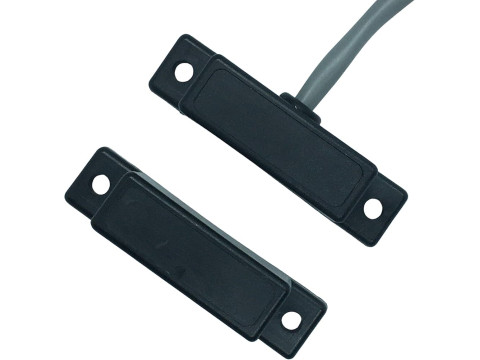A reed sensor—often called a reed switch sensor—is a magnetic contact device whose core principle revolves around a sealed, magnetically activated switch. When an external magnet approaches or recedes, the switch’s internal contact plates either close or open, generating an electrical output usable for monitoring or control tasks. Below, we discuss how reed sensors are constructed, their key characteristics, and their widespread applications in security systems, automation, and more.
1. How a Reed Sensor Works
1.1 Core Components
A reed sensor usually comprises two main elements:
- Reed Switch (Inside a Sealed Glass Tube):
Contains thin metal contact plates (often a ferromagnetic alloy). These plates come together or separate in response to an external magnetic field. The glass enclosure protects the contacts from dust, moisture, and corrosion. - Magnet (Separate Housing):
Positioned so that bringing it closer to the reed switch or moving it away induces switching. This magnet is typically installed on a moving part, such as a door or a float (in level sensing).
Because the contacts are enclosed in a hermetic seal, reed switches avoid oxidation and do not require any mechanical actuation mechanism. The absence of open spark formation allows them to be deployed safely in hazardous or explosive areas.
1.2 Advantages and Constraints
- Advantages:
- Reliable operation in dusty or humid environments
- No exposed sparking
- Minimal mechanical wear
- Straightforward wiring
- Constraints:
- Typically rated for low currents and voltages
- Limited operating gap (usually 1–3 centimeters, depending on magnet strength)
- Exhibits magnetic hysteresis – the distance at which the reed switch opens is greater than the distance at which it closes
Because reed sensors usually switch small currents, a relay or transistor-based interface can be added if the control circuit demands higher power.
2. Reed Sensor Specifications
Two vital characteristics in product datasheets are:
- Electrical Ratings:
Maximum switching current and voltage (often in the low-voltage DC range, like 24 VDC, but can be rated for modest AC voltages). - Activation/Deactivation Distances:
The “operate distance” indicates how close the magnet must be for the switch to close, while the “release distance” is how far the magnet must move for the switch to open.
Manufacturers sometimes list these distances as typical or maximum values. Over time, or under extreme conditions, a magnet’s field strength may diminish, so it’s wise to allow for margins during installation.
3. Common Reed Sensor Applications
3.1 Security and Alarm Systems
Reed sensors—frequently called magnetic contacts—are fixtures in many door/window security setups:
- Door/Window Alarms: The sensor half is secured to the door frame, with the magnet on the moving door or window. Opening the door separates the magnet from the reed switch, breaking or making a circuit and triggering an alarm.
- Tamper Detection: The sealed, contact-free design helps ensure durability and accuracy over years of repeated motion.
Installation tips include positioning the sensor and magnet carefully to accommodate door misalignment. Metal frames may weaken or redirect the magnetic field, so specialized or higher-strength magnets might be needed.
3.2 Liquid Level Sensing
Reed switches can be employed as float-based level sensors in tanks:
- Float with Magnet: Rises/falls with the fluid.
- Reed Switches: Placed at specific heights, each switch closes or opens when the float’s magnet aligns with it.
This enables multi-point level detection with minimal electronics. However, the gap between each reed switch must accommodate the magnet size and avoid simultaneous contact activation.
3.3 Position Feedback and Limit Switching
In machinery and automation:
- Conveyor Belt Systems: Indicate if a gate or stopper is fully open/closed.
- Shutter/Barrier Detection: Confirm if a movable barrier is locked in place.
- Robotics: Provide discreet position signals without mechanical wear, ensuring dependable feedback for end-of-travel detection.
4. Wiring and Installation Tips
- Two-Wire Connection:
A reed sensor’s normally open (NO) or normally closed (NC) contacts integrate easily into control loops. - Deciding Trigger Condition:
Some circuits detect a “closed circuit” as an event (magnet present), while others sense “open circuit” as a warning. Ensure consistent logic design across your system. - Mounting Accuracy:
Since reed sensors operate with limited distances, it’s best to carefully align components and minimize mechanical tolerances. - Environmental Factors:
Choose an IP-rated enclosure if the sensor faces harsh conditions—excessive dust, moisture, or temperature swings.
Conclusion
A reed sensor combines a reed switch (enclosed in a sealed glass tube) and a corresponding magnet to detect positions or changes in proximity. Widely used in alarm systems (doors/windows), fluid-level monitors, and industrial automation (machine position feedback), reed sensors are valued for their reliability, simplicity, and immunity to contaminants.
Despite limitations like short sensing ranges and low current ratings, reed sensors remain a go-to solution for many position-sensing tasks. By pairing them with suitable electronics, they provide accurate, maintenance-free, and cost-effective detection. For expert advice on selecting or integrating reed sensors, safsale.com offers reliable guidance to meet your application requirements.

